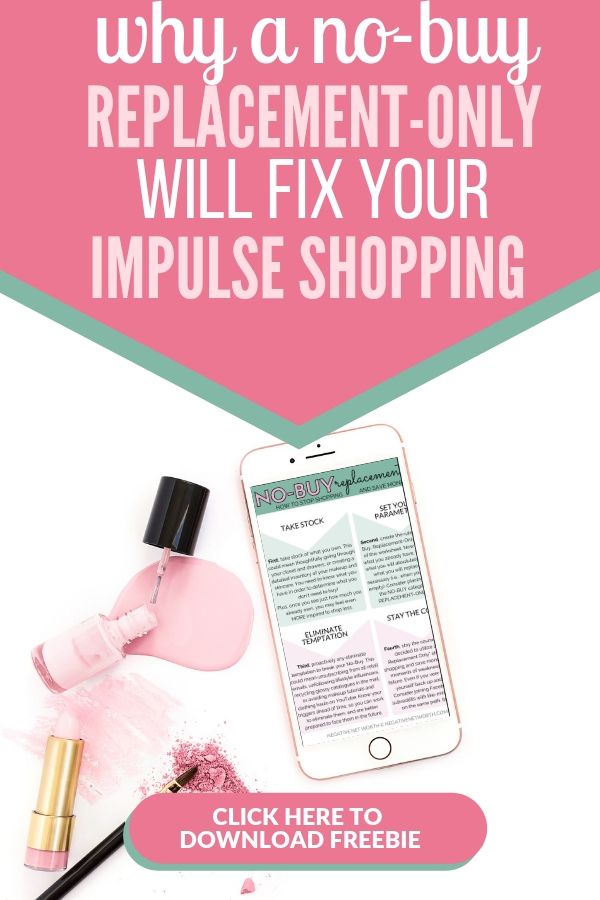
It may come as a surprise to some of you that I am not a huge fan of “low buys.” They are quite popular in the anti-consumption, minimalist, and stop-shopping communities. But to me, low buys are vague and wishy-washy, leave tons of room for error, and practically invite relapse.
If you’ve ever struggled with shopping or overspending, a “no-buy, replacement-only” strategy will change the way you shop, and save you money in the process.
Low Buys Don’t Work For Shopping Addicts
A “low buy” is, in theory, the absolute best way to shop for a person who has their impulses in check. But when you’re in the midst of a shopping problem…can you really depend on “shopping a little less” to change your habits? As I detailed in my post explaining the danger of low buys: no, you cannot.
The primary reason for this is as I explained:
Low buys … lull you into a false sense of complacency with an easy-to-achieve goal, which then skews your impulses to shop again when the “low buy” period ends. … When a “low buy” period ends for a spendthrift, do you know what happens? They immediately revert back to overspending.
From “Low Buys” Are Dangerous. Here’s Why. Check out that post for more info on low buys.
The No-Buy, Replacement-Only Strategy Works
What is a no-buy, replacement-only? It is when you delineate which items you will NOT buy at all—i.e., eye shadow, shoes, candles—and which items you will permit yourself to buy, but only when you need a replacement.
For instance, if you use (and enjoy!) foundation every day when you do your makeup, and you know you will run out, you might include foundation on your “replacement-only” list. And if you have a pair of black pumps you wear to work every day, and you know they are going to get worn out, you might also include pumps on your “replacement-only” list. It’s very specific to you, but you MUST create rules for yourself, and stick to them—otherwise, the strategy is useless!
You can use the “no-buy, replacement-only” strategy for a set period of time (3 months, 6 months, etc.) when you start out, or indefinitely. My recommendation is to start slow—1-3 months at first—in order to get used to the strategy. Then, when you see progress, and can control your impulses better, you likely will want to keep going!
The reason this strategy works is because—before you do ANYTHING else—you take the time understand what you truly want, need, and use on a regular basis. It forces you to anticipate future wants, and plan for potential obstacles.
Most of all, it gives you a measurable goal, with very specific rules, and someone to whom you can be held accountable: yourself.
How to Employ the “No-Buy, Replacement-Only” Strategy
So how do you employ this strategy? I suggest using my FREE No-Buy, Replacement-Only Worksheet included in The No Buy Workbook. There, you can:
- Learn the 4 steps for a successful No-Buy, Replacement-Only, and
- Create your own No-Buy, Replacement-Only rules for makeup, skincare, clothing, and home goods/electronics.
All in a free, fun printable, which you can leave on your desk as a daily reminder to stay strong…and stop shopping.
So let’s work through the No-Buy, Replacement-Only steps!
- Take stock. Take stock of what you own. This could mean thoughtfully going through your closet and drawers, or creating a detailed inventory of your makeup and skincare. You need to know what you have in order to determine what you don’t need to buy! Plus, once you see just how much you already own, you may feel even MORE inspired to shop less.
- Set your parameters. Create the rules for your No Buy using page 2 of of the No-Buy, Replacement-Only Worksheet, located in the Resource Library and The No Buy Workbook. Now that you know what you already have, you can decide what you will absolutely NOT buy, and what you will replace only when necessary. Consider placing more items in the NO-BUY category than the REPLACEMENT-ONLY category.
- Eliminate temptation. Proactively any eliminate temptation to break your No-Buy. Know your triggers ahead of time, so you can work to eliminate them, and are better prepared to face them in the future. More on this below.
- Stay the course. Once you’ve decided to do a No Buy, you will have moments of weakness and possible failure. Even if you veer off course, pick yourself back up and keep going! Consider joining Facebook groups or subreddits with like-minded individuals on the same path. Stay inspired.
Don’t forget to use page 2 of the worksheet. Fill out each category with your OWN rules for your No Buy. Then, eliminate temptation and stick with it!
For more information on how to ROCK your No Buy, check out this post.
You can do this! Let me know how it goes. 🙂

WANT TO REMEMBER THIS? SAVE THIS POST TO YOUR PINTEREST BOARD!


Leave a Reply